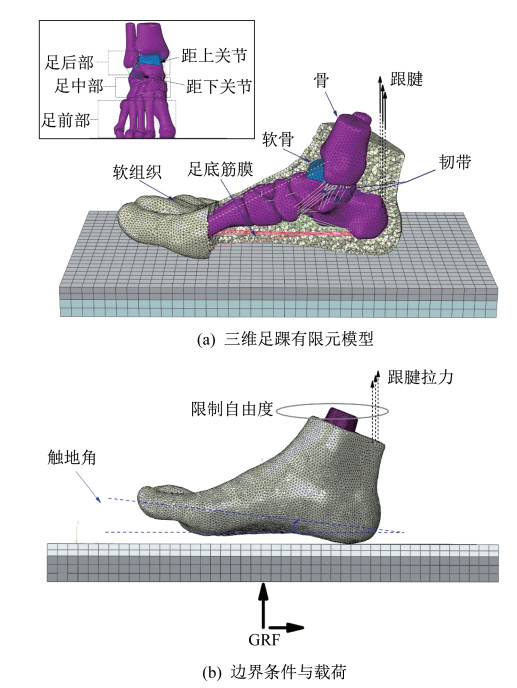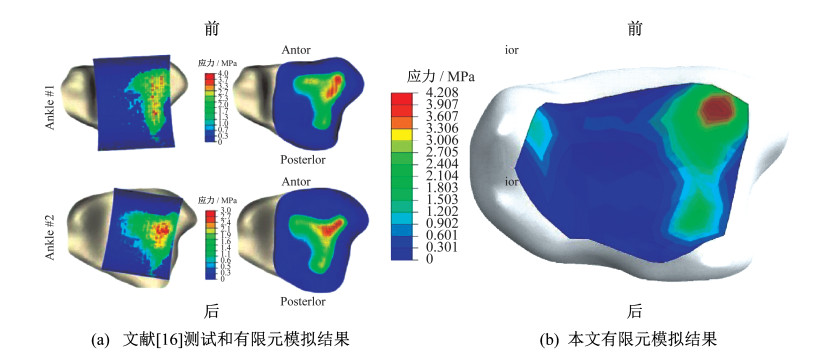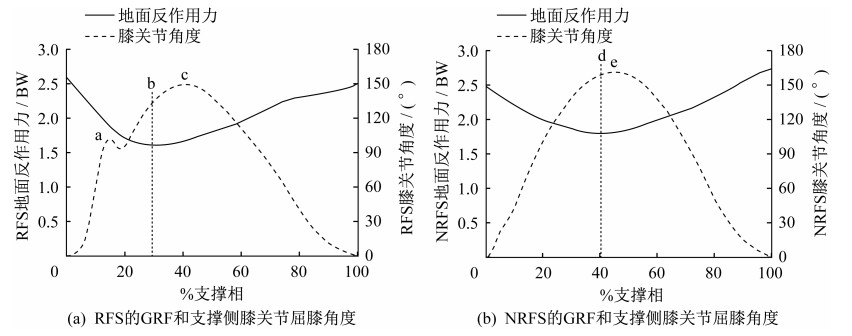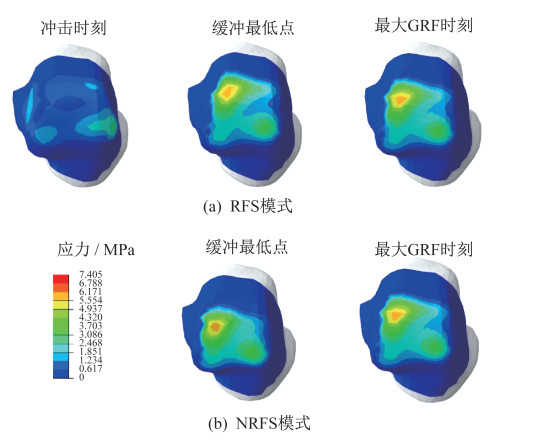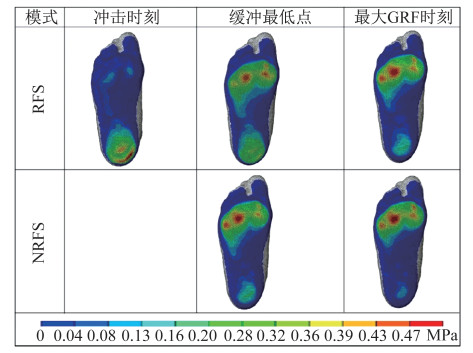Finite ElementAnalysis ofAnkle-Foot Complex During Different Strike Patterns of Jogging
-
摘要:目的 通过运动学、动力学分析结合有限元模拟的方法,探究不同慢跑触地模式下足中骨、距上关节面软骨、足底的应力分布特征及足底筋膜与踝关节韧带的受力情况。方法 采集8名研究对象在后足触地(rearfoot strike,RFS)和非后足触地(non-rearfoot strike,NRFS)模式下慢跑的运动学和动力学数据,选取1例踝关节活动范围在总体1倍标准差范围内的数据作为有限元分析的边界条件和载荷,建立三维足踝有限元模型,并予以验证。对2种触地模式下足踝结构进行有限元模拟,分析在不同触地模式中踝关节软骨的接触应力、韧带拉力、足底压力及骨的应力分布。结果 距上关节面软骨最大接触应力出现在NRFS的缓冲最低点,峰值为7.41 MPa。在RFS冲击时刻,距上关节面软骨接触应力最小,峰值为2.47 MPa。在RFS冲击时刻,足底压力峰值分布于足底的足跟后方区域,2种模式下足底压力峰值都出现在最大垂直地反力(ground reaction force,GRF)时刻。缓冲最低点的第1主应力最大峰值均出现在舟骨,RFS中更明显。NRFS模式下足底筋膜受力大于RFS模式。结论 2种模式距上关节面软骨上接触应力较为均匀,NRFS足底筋膜、楔舟足底韧带和弹簧韧带的受力大于RFS模式;足底筋膜炎人群不宜采取NRFS模式,长期的RFS模式可能会提高舟骨和足跟处的损伤风险。Abstract:Objective The biomechanical response of the mid-foot bone, articular cartilage, plantar fascia and the ligaments of ankle foot in different strike patterns was analyzed.Methods The kinematic and kinetic data of different foot strike patterns(FSPs)were acquired in 8 male volunteers.The measured data were used as loading and boundary conditions for further finite element(FE)analysis.A 3D FE model of ankle-foot complex was developed based on the computerized tomography(CT) of one male subject and validated.The stress of the bone, contact stress on the articular facet and tension of the plantar fascia were collected and analyzed.Results The peak contact stress of talocrural joint cartilage during NRFS was 7.41 MPa.The peak of first principal stresses has been found at the scaphoid in Max-buffer instant of RFS. At NRFS, tension of plantar fascia was found larger than in RFS.Conclusions Both patterns, the RFS and NRFS, had an even distribution of contact stress on the fact of the talocrural cartilage.And, larger tension applied on plantar fascia and plantar ligaments was found in NRFS.Long-term RFS jogging may increase the risk of scaphoid and heel damage.
-
骨质疏松症已经成为老年人中的常见慢性病,诊断老年人骨质疏松的主要手段为精确的骨密度(bone mineral density,BMD)测量。衰老及各种慢性疾病等的影响使老年人跌倒的发生率显著增长[1],老年人骨质疏松性骨折也由此成为高发现象,且往往伴随着慢性疼痛、残疾、生活质量下降和死亡率上升等情况[2-3],在世界各国都造成了较重的经济和医疗负担[4-5]。有研究报道,46~65岁妇女腰椎和股骨颈骨量减少和骨质疏松症发生率分别为40.7%和41.8%,远高于同龄男性,且随着体质量指数(BMI)的增加而增长[6]。研究显示,1980—2016年间中国老年人骨质疏松发生率不断增长,60岁以上老年人整体患病率达36%[7-9];中国老龄化的快速发展加剧了骨质疏松性骨折和相关的医疗成本给社会造成的负担。体育运动能使骨量和BMD均得到一定程度的增长,是机体骨峰值的重要决定因素之一,已成为国际公认预防老年人骨折的重要方法[10-11];而且适当的体育锻炼能有效抑制甚至逆转老年人骨的流失及BMD的下降[1],meta分析结果也显示运动可显著降低老年人椎骨骨折的概率[12]。然而,目前预防老年人骨折的运动干预方法较杂乱,可促进老年人骨骼健康和预防骨质疏松及骨折的高效锻炼方法有待尽快建立。
鉴于此,本文对国际上抗阻训练对老年人BMD干预的随机对照试验进行meta分析,探究抗阻训练对老年人全身BMD和下肢常见骨折部位BMD的影响,期待为我国老年人提供运动保护骨骼的方法,并为大众健身活动提供一定的理论基础。
1. 研究方法
本文meta分析所采用的研究方法与分析过程遵循国际指南《系统综述和元分析优先报告的条目:PRISMA声明》(Preferred Reporting Items for Systematic Reviews and Meta-Analyses: the PRISMA Statement)的建议和要求[13]。
1.1 文献检索
1.1.1 中国知网数据库
检索策略:“骨骼”并含“力量训练”或含“抗阻训练”。无附加限制条件。得到文献252篇,时间跨度为1989年1月—2017年5月。
1.1.2 PubMed数据库
检索策略:(bone or bone mineral density or bone density or BMD) AND (exercise or physical activity or resistance training or strength training) AND (old or elderly)。限制条件:Randomized Controlled Trial,Humans,English。得到文献1 389篇,时间跨度为1970年1月—2017年5月。
1.1.3 ScienceDirect数据库
检索策略和限制条件同1.1.2。得到文献1 330篇,时间跨度为1975年1月—2017年5月。
1.1.4 WOSTM数据库
检索策略同1.1.2,无附加限制条件。得到文献295篇,时间跨度为1992年1月—2017年5月。
1.1.5 Cochrane Library数据库
检索策略同1.1.2,限制条件为“Trails”。得到文献510篇,时间跨度为1970年1月—2017年12月。
1.1.6 Embase数据库
检索策略同1.1.2,限制条件为“Randomized Controlled Trial”或“Controlled Clinical Trial”。得到文献73篇,时间跨度为1996年1月—2017年9月。
国际数据库检索文献出版语言均限制为英语,文献资料搜集仅限于已发表文献。检索由本文第1和第2作者按照上述策略分别完成(遇到分歧通过小组讨论解决)。为对研究内容更好地把握,本文首先对meta分析本身进行检索分析。
1.2 文献纳入和剔除标准
1.2.1 纳入标准
① 研究类型:随机对照试验;②受试者类型:受试者平均年龄≥60岁,无严重影响运动能力和严重影响骨代谢的疾病;③干预类型:试验干预方法为抗阻训练,对照组无规律性运动;④纳入指标及测量:测量指标包含全身及下肢BMD(有3篇及以上的文献报告的指标才纳入meta分析),使用测量仪器和方法等得到国际认证;④试验数据处理:试验数据包含试验前和试验后或试验前后对比的效应量和标准差探究。为降低纳入文献偏倚风险,本文英文仅纳入SCI收录论文,中文仅纳入核心期刊论文或硕博士学位论文。
1.2.2 剔除标准
① 干预方法:抗阻与其他形式的运动结合,无空白或无运动的对照组;②受试对象:平均年龄 < 60岁,存在运动能力严重受损的状况如残疾等,患有糖尿病、严重肥胖和癌症等严重影响代谢的疾病;③数据处理或报告形式:无试验前后指标变化的“均值±标准差”(x±s)或无法计算试验前后指标变化的x±s。
1.3 数据信息提取
建立表格,通过标准化流程提取纳入文献中受试者平均年龄或范围、平均BMI或范围、试验持续时间、试验组详细干预方案、分析指标的结果、测试方法和对照组处理等信息。指标数据:全身BMD和下肢部分(腰椎、髋关节、股骨大转子、股骨颈)BMD在试验前后变化的量。试验数据提取形式和转换:①直接提取试验组样本量(N)和干预前后数据的x±s;②试验前后效应量的x±s通过公式转换;③试验组干预前后效应量的x±s及统计学趋势P值,运用软件内置计算器计算;④试验组与对照组或2个试验组的N,组间效应量比较的均数差(mean differences)、置信区间上限或下限和P值,运用软件内置计算器计算[14]。数据提取由本文第1位和第2位作者分别完成,结果汇总后经过小组讨论解决分歧并进行重复提取对照。
1.4 统计学处理
采用ReMan 5.3.5数据处理软件,对纳入文献进行偏倚性评估、异质性检验、数据合并及偏倚图和森林图绘制,并对数据进行敏感性检验。数据类型及合并模型:处理数据为连续性变量,使用效应量标准均数差(standard mean difference, SMD)和95%置信区间;采用随机效应模型对所纳入数据进行处理。异质性判断(以I2值为主):I2≤50%可以忽略异质性;50%<I2≤70%具有中度的异质性;I2=79%则表明数据异质性较高,不可忽略,需要讨论异质性来源。数据敏感性检验:采用数据逐条剔除的方法检验数据的敏感性;某组数据中存在改变其统计学意义的单条数据则视该组数据为高敏感性数据。发表偏倚检验:通过软件制作漏斗图,纳入文献10篇及以上的指标,P < 0.05则存在显著的发表偏倚;敏感性数据和存在发表偏倚的数据合并结果应保守对待。统计学方法的选择由文献评估小组根据数据特点与meta分析相关国际指南决定,数据分析由本文第1位作者独立完成;数据及结果由小组其他人员复查并汇总,以避免人为导致的错误。
2. 结果
2.1 文献的筛选与纳入
通过检索CNKI、PubMed、ScienceDirect、WOSTM、Cochrane Library和Embase等数据库共得到文献3 849篇,阅读相关meta分析得到文献12篇,去重复处理后得到文献2 706篇。对所得文献进行标题筛选、摘要筛选、内容阅读和数据筛选等处理,最后纳入符合meta分析要求的文献17篇[15-31](具体流程见图 1)。由本文第1位和第2位作者分别完成,遇到分歧由小组讨论决定。
2.2 纳入文献基本情况和方法学偏倚评价
纳入总样本量为719人,其中21名受试者患有骨质疏松,平均年龄≥60岁,均无严重影响运动能力和正常代谢的疾病。文献方法学偏倚评估使用Cochrane系统评价标准,分别从随机分组产生、隐蔽分组、双盲试验、效应指标盲检、试验数据不完整、试验指标选择性报告、其他偏倚等7个评价指标,对纳入的17篇文献偏倚风险进行综合评价,结果显示:低偏倚风险6篇,中等偏倚风险9篇,偏倚风险较高2篇,偏倚风险评估结果如图 2所示;纳入文献的基本情况如表 1所示。
表 1 纳入文献基本情况一览Table 1. The basic situation table of the included literatures第一作者及
发表年份年龄/岁 BMI/
(kg·m-2)D/周 运动方案 指标效应 测试方法 对照组
处理训练强度 训练量 训练部位 Nelson1994 61.1±3.7 24.4±2.5 52 50%~60%1RM逐渐增至80%1RM,每4周更新强度 2次/周,45 min/次,3组重复8次 腰背和下肢肌肉为主 股骨颈: 0.005,↑腰椎: 0.009,↑ DEXA 保持原有生活方式 Pruitt 1995 68.5 24.9 48 高强度组80%1RM低强度40%1RM 3次/周,60 min/次,2组重复7次 上下肢和腰腹主要肌群 股骨颈: 0.025,↑腰椎: 0.007,NS髋关节: 0.008,NS DEXA 空白对照 Rhodes 2000 68.8 — 52 75%1RM,每2周更新强度 3次/周,60 min/次,3组重复8次 上下肢和腰腹主要肌群 股骨颈: 0.01,NS腰椎: 0.03,NS大转子: 0.01,NS DEXA 保持原有生活方式 Kerr 2001 60±5 — 96 8RM,约80%1RM 3次/周,60 min/次,3组重复8次 上下肢和腰腹主要肌群 股骨颈:1.04,NS腰椎: -0.65,NS大转子: 0.0,NS髋关节: 0.57,↑ DEXA 每天补充钙600 mg,无运动 Jessup 2003 69.2±3.5 — 32 由50%1RM增至75%1RM,负重楼梯重量从0增至10%体质量 3次/周,(60~90) min/次,20 min力量训练,重复8~10次,30~45 min负重爬楼梯 下肢主要肌群 股骨颈: 0.07,↑腰椎: 0.11,↑ DEXA 空白对照 Liu-Ambrose 2004 79±3 — 25 强度50%~60% 1 RM,4周后强度75%~85%1RM 2次/周,50 min/次,2组,重复由10~15次调整至6~8次 上下肢主要肌群 股骨颈: -0.002,NS髋关节: 0.001,NS大转子: 0.01,NS DEXA 拉伸和放松活动 Verschueren 2004 64.1 26.4 24 60%~80%最大心率 3次/周,60 min/次,第1~14周2组,第15~24周3组 下肢主要肌群 髋关节: 0.014,↑全身: -0.005,NS DEXA 保持原有运动状态 Chuin 2009 66.1±3.3 26.3 24 80%1RM,每4周更新1次强度 3次/周,60 min/次,3组重复8次 上下肢和腰腹主要肌群 股骨颈: 0.0,NS腰椎: -0.01,NS DEXA 保持原有生活方式 Bocalini 2009 68.2 27.6 24 强度渐增至85%1RM 3次/周,60 min/次,3组重复10次 上下肢和腰腹主要肌群 股骨颈: -0.001,NS腰椎: -0.001,NS DEXA 空白对照 Marques 2011 67.6 28.4 32 强度渐增至75%~80%1RM,每4周更新1次强度 3次/周,60 min/次,2组重复6~8次 上下肢和腰腹主要肌群 股骨颈: -0.008,NS髋关节: 0.014,↑大转子: 0.02,↑ DEXA 空白对照 Kukuljan 2011 60.4 27.9 72 前4周50%~60%1RM,后8周80%~85%1RM循环训练 3次/周,(60~75) min/次,前12周2组重复15~20次, 后每12周1个循环(前4周与1~12周相同,后8周2组重复8~12次) 上下肢和腰腹主要肌群 腰椎: 0.7,NS大转子: 1.1,↑ DEXA 空白对照 Romero-
Arenas 201361.6±5.3 29.9 12 50%~75%1RM 2次/周,45~87 min/次,2组重复6~12次 下肢和腰腹肌群 全身: 0.01,↑ DEXA 空白对照 Mosti 2013 64.3 25.1 12 下蹲机40%1RM热身,随后85%~90% 1RM 3次/周,2组重复8~12次, 随后4组重复3~5次 下肢肌群 股骨颈: 0.004,NS腰椎: 0.003,NS髋关节: 0.005,NS DEXA 补充钙和维生素D,无运动 Gualano 2014 66.2 27.5 24 第1周60%1RM,第2周至结束70%~80%1RM 2次/周,第1周2组重复15~20次,第2周至结束3组重复8~12次 上下肢和腰腹主要肌群 股骨颈: -0.01,NS腰椎: -0.01,NS全身: 0.0,NS DEXA 安慰剂 Watson 2015 66.1 23.6 32 50%~70%1RM热身,80%~85%1RM主体训练 2次/周,30 min/次,5组重复5次 下肢肌群 股骨颈: 0.014,↑腰椎: 0.0021,↑ DEXA 30 min简单锻炼 Nicholson 2015 65.8 25.7 24 — 60 min杠铃操 上下肢和腰腹主要肌群 全身: -0.57,NS髋关节: -0.21,NS股骨颈: 0.11,NS腰椎: 1.01,↑大转子: -0.52,NS DEXA 保持原有运动状态 Duff 2016 64.8 — 36 脉冲健身系统或克服自身重量 3次/周,2组重复8~12次 上下肢和腰腹主要肌群 髋关节: 0.008,NS腰椎: -0.003,NS股骨颈: -0.002,NS大转子: 0.004,NS DEXA 补充钙和维生素D 注:/为无相关数据;↑为显著提高;NS为无统计学意义;↓为显著降低;D为周期(duration);DEXA为双能X线吸收测量法;受试者年龄与BMI以“均值±标准差”表示,文中信息无法计算“标准差”则计算出“均值”;指标效应指试验组干预后各指标与干预前的差值及统计学意义。 2.3 meta分析结果
2.3.1 抗阻训练对老年人全身BMD的影响
抗阻训练对老年人全身BMD影响数据合并共纳入文献6篇,纳入样本量为241人。meta分析结果显示(图 3):抗阻训练对老年人全身BMD影响数据合并结果无显著性(SMD=0.21,I2=68%,P=0.38)。
2.3.2 抗阻训练对老年人腰椎BMD的影响
抗阻训练对老年人腰椎BMD影响数据合并共纳入文献13篇,纳入样本量为480人。
meta分析结果显示(图 4):抗阻训练对老年人腰椎BMD具有显著的提高作用(SMD=0.46,I2=70%,P=0.01)。
2.3.3 抗阻训练对老年人髋关节BMD的影响
抗阻训练对老年人髋关节BMD影响数据合并共纳入文献8篇,纳入样本量为354人。
meta分析结果显示(图 5):抗阻训练对老年人髋关节BMD有显著的提高作用(SMD=0.34,I2=16%,P=0.005)。
2.3.4 抗阻训练对老年人股骨大转子BMD的影响
抗阻训练对老年人股骨大转子BMD影响数据合并共纳入文献6篇,纳入样本量为293人。meta分析结果显示(图 6):抗阻训练对老年人股骨大转子BMD没有显著的影响(SMD=0.22,I2=56%,P=0.22)。
2.3.5 抗阻训练对老年人股骨颈BMD的影响
抗阻训练对老年人股骨颈BMD影响数据合并共纳入文献14篇,纳入样本量为501人。meta分析结果显示(图 7):抗阻训练对老年人股骨颈BMD有显著的提高作用(SMD=0.53,I2=60%,P=0.000 5)。
2.3.6 数据敏感性检验
结果显示:全身、腰椎、髋关节、股骨大转子和股骨颈BMD数据合并meta分析中所有数据逐条剔除均没有影响结果的统计学趋势,说明本文所有数据合并结果均无敏感性数据出现。
2.3.7 发表偏倚检验
图 8、9为所有指标数据合并制作的漏斗图(纳入文献10篇及以上)。由图可见, 腰椎BMD(Begg检验:t=1.37,P=0.196)和股骨颈BMD(Begg检验:t=1.14,P=0.273)数据不存在发表偏倚。
3. 讨论
3.1 抗阻训练可提高老年人BMD
本文尽管纳入文献数据显示抗阻训练对老年人全身BMD和股骨大转子BMD有改善作用,但合并分析后效应量没有统计学意义(P > 0.05)。本文中抗阻训练对老年人腰椎、髋关节和股骨颈BMD的提高均具有显著性(P < 0.05)。纳入文献中仅Romero-Arenas等[26]的研究结果显示抗阻训练可显著提高老年人全身BMD,Nicholson等[30]的结果显示老年人全身和股骨大转子BMD均出现下降的趋势,可能与该研究抗阻训练强度较小且具有较多有氧成分有关;且以爆发力为主的抗阻训练对老年人BMD的改善效果显著优于以力量为主的抗阻训练,可能与爆发力为主的抗阻训练骨骼瞬间的“应力”比以力量为主的抗阻训练大有直接关系[32]。还有研究显示,虽然抗阻训练与抗阻添加平衡训练对老年妇女骨骼健康都有提高作用,且2种方法的干预效果间不存在显著性差异[33];但5年后的随访数据显示,单纯的抗阻训练组受试者跌倒骨折的概率并未明显低于对照组,两组间差异无统计学意义;而抗阻结合平衡训练组受试者跌倒的概率和跌倒后骨折的概率都显著低于对照组[34]。提示对老年人骨骼的保护及骨质疏松性骨折的预防可能需要多种运动方式相结合,期待开展更多随机对照试验进行探究。
另外,Marques等[24]和Kukuljan等[25]的研究都显示抗阻训练可显著提高老年人股骨大转子的BMD;其他报道老年人全身和股骨大转子BMD的文献都显示抗阻训练对老年人全身和股骨大转子BMD的提高有利。Kelley等[35-37]对体育锻炼干预男性和女性BMD的随机对照试验分别进行了meta分析,受试者均为成年人;结果显示,抗阻训练对女性BMD有积极的影响;体育锻炼可以改善或至少使男性BMD保持较平稳的状态,关节应力性的体育运动可显著提高男性腰椎和股骨颈的BMD。也有meta分析与本文结果不同。如Marques等[1]对所有运动干预老年人BMD的研究进行了meta分析,结果显示体育锻炼可显著改善老年人BMD(P < 0.05)。其中纳入抗阻训练对老年人BMD影响的共7篇(腰椎BMD为干预指标的7篇,股骨颈BMD为干预指标的6篇);数据合并结果显示抗阻训练有改善老年人腰椎和股骨颈BMD的趋势,但没有统计学意义(P > 0.05)。董宏等[38]对体育锻炼对中老年人BMD的影响进行了meta分析,结果显示:有氧训练(纳入11篇文献)可显著提高老年人BMD(P < 0.05),抗阻训练(纳入9篇文献)对中老年人BMD无显著影响(P > 0.05)。Zhao等[39]的meta分析结果显示,抗阻训练结合负重训练或冲击性运动可显著提高绝经女性腰椎和股骨颈BMD(P < 0.05),但单独抗阻训练对绝经女性BMD的改善作用没有显著性影响(P > 0.05)。以往meta分析和本文中的结果都显示抗阻训练对老年人BMD具有一定的提高作用;而本文纳入了较新的研究且纳入文献的数量都超过以往meta分析,这可能是与以往meta分析结果不尽相同的主要原因。
3.2 抗阻训练可促进骨质排列紧密及骨骼的合成
老年人BMD下降的主要原因是进入老龄阶段后,由于营养物质如雌激素、类胰岛素生长因子-I(IGF-I)、维生素D减少导致骨髓干细胞分化能力下降,人体成骨细胞活性降低,而增加破骨细胞活性的细胞因子如白细胞介素-1(IL-1)和肿瘤坏死因子-α(TNF-α)等表达增加,这些因素的共同作用使老年人骨质疏松发生的概率显著增加[40]。有研究提出BMD能在一定程度反映上老年人跌伤的风险,但长期预测老年人骨质疏松的风险还需要对老年人骨代谢相关因子进行定期测量[41]。另外,影响代谢的疾病如肥胖症和2型糖尿病等会进一步破坏白细胞介素和瘦素等维持骨骼健康因子的代谢平衡,加速由老龄化导致的骨吸收;同样使老年人循环维生素D等骨营养物质水平显著降低,对老年人的骨流失造成额外的负面影响[42-43]。骨骼长期应力过小也会促进骨吸收的发展,使老年人BMD持续下降。老年人认知功能障碍独立于其他因素增加老年人跌倒的风险,认知功能障碍的老年人跌倒的概率是认知功能健康老年人的2倍,极大增加了老年人骨质疏松性骨折的风险[44-45]。生活环境中汽车尾气和雾霾中含有少量的镉等重金属,而近期研究显示饮食和香烟中含的镉等重金属会显著增加老年人骨的流失,即使是极少量的镉暴露也会显著降低老年人BMD并增加老年人骨折的概率[46]。
抗阻训练可通过给予骨骼物理压力和改善老年人肌肉质量等使老年人的BMD提高:构成松质骨主要部分的骨小梁的排列方向和紧密程度受骨骼应力的方向和大小影响,其中应力方向又分为重力应力和骨骼肌收缩应力,两者共同构成骨骼的应力系统;骨骼长期承受较强的负荷则会使BMD增加[47-48]。抗阻训练可显著改善老年人肌肉质量(骨骼肌的量和肌肉力量)已得到广泛的验证。骨骼肌质量是骨骼强度的重要决定因素,骨骼肌质量的提高对于老年人骨质疏松的预防和治疗都具有重要意义,国内专家也就肌肉与骨骼的紧密联系达成了相关共识[49]。本文纳入文献中Rhodes等[17]、Duff等[31]、Nicholson等[30]和Mosti等[27]的研究也都显示,抗阻训练提高老年人BMD的同时往往也伴随着肌肉质量的改善。Lee等[50]的研究结果显示,肌肉量的保持有助于预防老年女性股骨的流失和骨质疏松的发生;力量性锻炼对老年女性骨量的保持具有积极的影响。Belav 等[51]的研究发现,肌肉神经系统的协同表现(最大肌力)与骨量、皮质骨形态学特征和骨强度有显著的相关性,甚至超过骨矿物和BMD的作用;认为骨骼承受的负荷是骨骼保持形态学特征和基本功能的关键。而Drey等[52]的研究显示,骨质疏松-肌萎缩综合征患者、单纯骨质疏松患者和肌肉萎缩的老年人与健康老年人比较,握力和肌肉功能指标都有显著的差异,同时骨代谢因子(促进骨的流失)也处于较高的水平,具有更高的跌倒和骨折概率。上述结果说明,骨骼肌质量和BMD均为预防老年人跌伤不可忽视的因素;就此而言,抗阻训练对老年人跌伤的预防作用是不可替代的。
抗阻训练可影响骨骼肌骨代谢因子的分泌:骨骼肌可分泌多种调控骨骼代谢,促进骨骼发育、修复和重塑的因子[49];Yuan等[53]对国际上运动对骨质疏松影响的研究进行了综述,列出了运动在骨质疏松预防和治疗中具有积极效果的重要证据,其中包含运动对多种影响骨代谢的激素和细胞等的改善作用。另有最新研究结果显示,12个月干预试验结束后,抗阻训练组老年人甲状旁腺激素(PHT)等促进骨吸收的激素水平显著下降,IGF-I和维生素D等骨营养因子的循环水平显著升高[54]。也有研究显示,有氧运动对老年人骨骼的影响主要体现在增加骨骼的合成能力,对老年人BMD的影响存在一定争议[55]。赵静[56]关于运动对绝经女性BMD影响的meta分析纳入了有氧和抗阻2种训练为干预方法的文献,结果显示纳入运动干预对绝经女性髋关节、腰椎和股骨颈BMD均无显著改善;与本文结果有较大差异,产生这种结果的原因可能是有氧训练干预效应的影响。本文纳入文献Kerr等[18]和Marques等[24]的研究结果都显示:抗阻训练可显著改善老年人部分BMD,而有氧运动干预组老年人BMD与对照组相比均无显著改变。但影响骨代谢的激素和细胞种类众多,作用机制也较为复杂;抗阻训练对骨代谢因子影响的机制和影响因素仍不清楚,仍需要更多高质量的研究验证[57]。
3.3 不同训练负荷对老年人BMD的影响存在差异
Bemben等[58]的研究显示,抗阻训练对老年人BMD的影响趋向于强度越高效果越好,频率越高效果越好;但中等强度与高强度间的效应量差不具有统计学意义,每周2次训练与每周3次训练的效应量没有显著性差异;将训练频率和强度进行交叉比较发现,老年男性和女性的干预效应也不存在显著的差异性。Borba-Pinheiro等[59]的研究结果显示,抗阻训练每周3次比每周2次对绝经女性BMD改善效果好,但效应量差异仍不具有显著性;本文纳入文献Marques等[24]的研究也显示,抗阻训练强度对老年人BMD的影响不存在显著性差异。也有研究指出,体育运动的频率和每次运动持续的时间对老年女性骨骼的适应性改变起到关键性的影响。有研究指出,运动和体育锻炼对老年人BMD产生影响干预周期最小为24周,但目前仍没有随机对照试验或meta分析针对此类问题进行探究;运动周期对老年人BMD的影响仍无明确的定论。但国际上有研究显示骨的重建需要约3~4个月的时间,而要增加骨量则需要7~9个月甚至更久;而且本文纳入文献中Pruitt等[16]、Rhodes等[17]和Marques等[24]的研究周期均超过7个月,抗阻训练组老年受试者骨代谢因子都有一定的改变,这对老年人运动干预骨骼健康具有一定的指导意义。董宏等[38]的meta分析还探究了体育锻炼的不同负荷对中老年人BMD的影响,结果显示体育锻炼在12个月以上才可显著提高中老年人BMD,每周锻炼频率大于3次效应量才具有显著性,每次锻炼时间在30~60 min效应量才具有显著性。当前,对抗阻训练频率、强度和单次训练持续时间对老年人BMD影响及性别差异等问题还没有明确试验结论;但运动训练负荷作为运动训练效果实现的基础,尤其是针对老年人群特征的负荷控制需要更多的高质量研究进行验证。
3.4 研究适用范围及局限性
本文共纳入719名年龄为50~95岁受试者(男性约占18%),其中仅有约3%患有骨关节炎,97%受试者均无重大疾病或影响骨代谢的慢性病;故本文结果更适用于大众健身与骨质疏松的预防。本文纳入受试者性别差异较大,整体年龄跨度也较大;这在一定程度上影响研究结果的针对性。女性绝经后BMD会出现快速下降,下降幅度和量都显著大于老年男性;因此将老年男性和女性数据统一合并可能影响性别特征的体现。由表 1可知,本文纳入meta分析的文献中使用抗阻训练的干预方案虽然都为抗阻训练,但仍存在一定异质性,试验干预的周期也有较大差距;这些都可能对研究结果产生影响。
4. 结束语
抗阻训练对老年人BMD有一定提高作用;对老年人腰椎、髋关节和股骨颈BMD均具有显著的提高作用。适当的抗阻训练可有效保护老年人骨骼,预防骨质疏松。
-
表 1 各种组织的材料属性与单元类型
Table 1 Material properties and element types of the finite element model
表 2 足底筋膜和韧带受到的拉力
Table 2 Tension of the plantar fasica and ligaments of foot
韧带 RFS拉力/N NRFS拉力/N 缓冲最低点 最大GRF时刻 缓冲最低点 最大GRF时刻 足底筋膜 58.3 65.1 147.0 121.2 足底长韧带 16.6 35.0 16.6 19.3 弹簧韧带 22.4 29.8 35.0 38.8 楔舟足底韧带 18.4 35.0 55.2 60.7 -
[1] GENT R N, SIEM D, MIDDELKOOP M V, et al. Incidence and determinants of lower extremity running injuries in long distance runners:A systematic review[J]. British Journal of Sports Medicine, 2007, 41(8):469-480 doi: 10.1136/bjsm.2006.033548
[2] AHN A N, BRAVTON C, BHATIA T, et al.Muscle activity and kinematics of forefoot and rearfoot strike runners[J]. Journal of Sport and Health Science, 2014, 3(2):102-112 doi: 10.1016/j.jshs.2014.03.007
[3] GRUBER A H, BOYER K A, DERRICK T R, et al.Impact shock frequency components and attenuation in rearfoot and forefoot running[J]. Journal of Sport and Health Science, 2014, 3(2):113-121 doi: 10.1016/j.jshs.2014.03.004
[4] LIEBERMAN D E, VENKADESAN M, WERBEL W A, et al.Foot strike patterns and collision forces in habitually barefoot versus shod runners[J]. Nature, 2010, 463(7280):531-535 doi: 10.1038/nature08723
[5] GIANDOLINI M, HORVAIS N, ROSSI J, et al.Foot strike pattern differently affects the axial and transverse components of shock acceleration and attenuation in downhill trail running[J].Journal of Biomechanics, 2016, 49(9):1765-1771 doi: 10.1016/j.jbiomech.2016.04.001
[6] COVENTRY E, O'CONNOR K M, HART B A, et al.The effect of lower extremity fatigue on shock attenuation during single-leg landing[J]. Clinical Biomechanics, 2006, 21(10):1090-1097 doi: 10.1016/j.clinbiomech.2006.07.004
[7] BECKER J, PISCIOTTA E, JAMES S, et al. Center of pressure trajectory differences between shod and barefoot running[J].Gait and Posture, 2014, 40(4):504-509 doi: 10.1016/j.gaitpost.2014.06.007
[8] MCCARTHY C, FLEMING N, DONNE B, et al.12 weeks of simulated barefoot running changes foot-strike patterns in female runners[J]. International Journal of Sports Medicine, 2014, 35(5):443-450 doi: 10.1055/s-0033-1353215
[9] ALTMAN A R, DAVIS I S. A kinematic method for footstrike pattern detection in barefoot and shod runners[J]. Gait and Posture, 2012, 35(2):298-300 doi: 10.1016/j.gaitpost.2011.09.104
[10] NIU W X, WANG L J, FENG T N, et al.Effects of bone young's modulus on finite element analysis in the lateral ankle biomechanics[J].Applied Bionics and Biomechanics, 2013, 10(4):189-195 doi: 10.1155/2013/818414
[11] ATHANASIOU K A, LIU G T, LAVERY L A, et al. Biomechanical topography of human articular cartilage in the first metatarsophalangeal joint[J]. Clin Orthop Relat Res, 1998, 348(348):269-281 http://www.ncbi.nlm.nih.gov/pubmed/9553561
[12] SIEGLER S, BLOCK J, SCHNECK C D.The mechanical characteristics of the collateral ligaments of the human ankle joint[J].Foot Ankle, 1988, 8(5):234-242 doi: 10.1177/107110078800800502
[13] WRIGHT D G, RENNELS D C. A study of the elastic properties of plantar fascia[J]. Journal of Bone & Joint Surgery American Volume, 1964, 46:482-492 http://www.ncbi.nlm.nih.gov/pubmed/14131427
[14] ZHANG M, MAK A F T. In vivo friction properties of human skin[J]. Prosthetics and Orthotics International, 1999, 23(2):135-141 doi: 10.3109/03093649909071625
[15] WANG Y, LI Z, ZHANG M. Biomechanical study of tarsometatarsal joint fusion using finite element analysis[J]. Medical Engineering and Physics, 2014, 36(11):1394-1400 doi: 10.1016/j.medengphy.2014.03.014
[16] ANDERSON D D, GOLDSWORTHY J K, LI W, et al. Physical validation of a patient-specific contact finite element model of the ankle[J].Journal of Biomechanics, 2007, 40(8):1662-1669 doi: 10.1016/j.jbiomech.2007.01.024
[17] YU J, CHEUNG J T M, FAN Y, et al. Development of a finite element model of female foot for high-heeled shoe design[J].Clinical Biomechanics, 2008, 23(1):31-38 https://www.sciencedirect.com/science/article/pii/S0268003307002082
[18] WAN L. In-vivo cartilage contact biomechanics: An experimental and computational investigation of human ankle joint complex[D]. Boston: Massachusetts Institute of Technology, 2008: 221-222
[19] LYGHT M, NOCKERTS M, KERNOZEK T, et al.Effects of foot strike and step frequency on achilles tendon stress during running[J]. Journal of Applied Biomechanics, 2016, 32(4):365-372 doi: 10.1123/jab.2015-0183
[20] NIU W X, TANG T T, ZHANG M, et al. An in vitro and finite element study of load redistribution in the midfoot[J]. Science China Life Sciences, 2014, 57(12):1191-1196 doi: 10.1007/s11427-014-4731-1
-
期刊类型引用(2)
1. 肖晓飞,李旭鸿,郝卫亚. 体操自由操落地双侧下肢生物力学对称性研究. 应用力学学报. 2022(02): 247-254 .  百度学术
百度学术
2. 国婷婷,谢红. 有限元法在足踝生物力学研究中的应用进展. 医用生物力学. 2022(04): 766-770 .  百度学术
百度学术
其他类型引用(6)





 下载:
下载:








